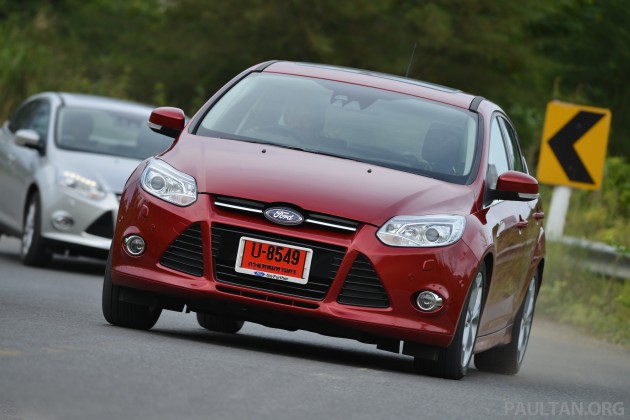
Those in the market for a C segment car are spoilt for choice. 2012 has so far yielded us the Hyundai Elantra, Peugeot 408, facelifted 308 and new Honda Civic, joining the usual suspects. A new contender is just across the border now, waiting for its official launch this September – it is the new Ford Focus.
This third-generation Focus is the latest One Ford product from the Blue Oval, which means that the Focus, available here in both five-door hatchback and four-door sedan form, will be sold across the globe as the same car (with at least 80% common parts, Ford says), bucking the previous trend where North America got a poorer Focus.
Thailand is one of five global production hubs for the Focus (the others are in Germany, Russia, USA and China) and output from the new US$450 million Ford Thailand Manufacturing factory in Rayong will serve the Asia Pacific region. Our northern neighbour also recently played host to the regional Focus media preview, which we attended.
Continue reading for our first drive impressions of the new Ford Focus.
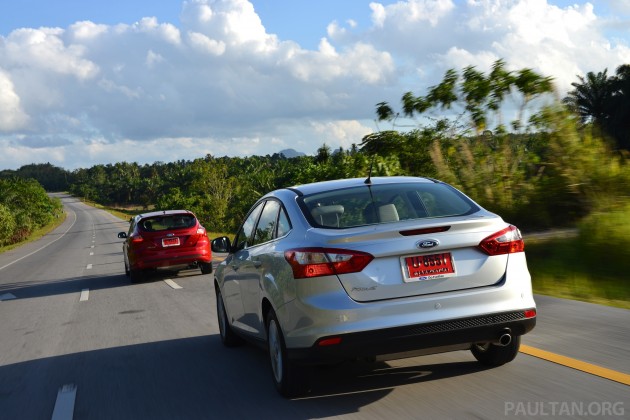
As mentioned, two body styles are available, the five-door hatchback (no three-door exists for now, even in Europe) and a sedan, and Rayong gives them two engines – 1.6 and 2.0 litre GDI (gasoline direct injection) petrol units with DOHC and Ti-VCT (twin independent variable camshaft timing), which means that these engines are as modern as they come for naturally aspirated units.
The demanding Malaysian market will only get the 2.0L, which makes 170 hp and 202 Nm of torque from 4,550 rpm, which is high for the class. As expected, no manual option for us, so it’s a six-speed Powershift dual-clutch gearbox for your Focus. Unlike in the Fiesta, the ‘box gets manual override (Ford calls it SelectShift) in the form of +/- buttons on the gearknob. More on that later.
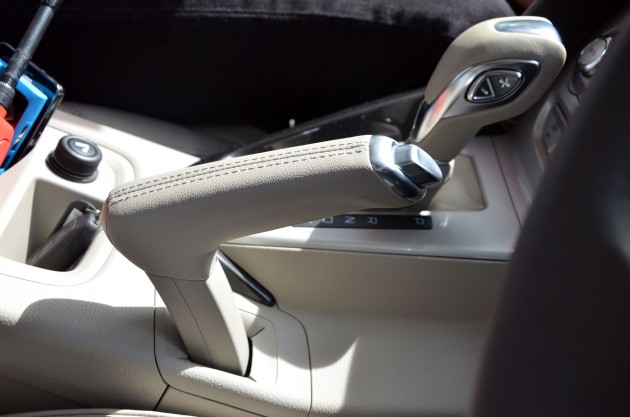
There are many who have, and will, claim that we’re being “shortchanged” by Ford as there’s no Ecoboost turbo option. Well, if you feel so, punters in USA and Australia (which I’m sure you will agree are more sophisticated markets) get the same GDI engine as us. So you’re in good company. Also bear in mind that apart from the Peugeot 308 and the significantly costlier Golf TSI, no other C-segment offering offers more power, GDI or a turbo, here.
Still want Ecoboost + manual? You’ll have to wait for the Focus ST. In the meantime, take off those “I want cheap, nice and good” tinted glasses and the Focus can be viewed as competitive, class leading even, when one starts to dive into the spec sheet.
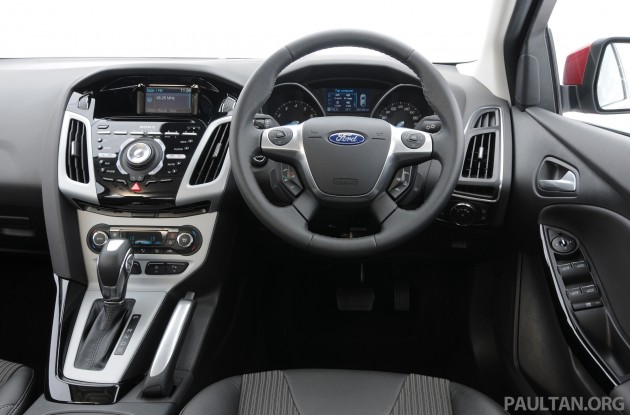
Malaysia will only get the two top trim levels for each body style – Sport and Sport + for the hatch, Titanium and Titanium + for the sedan. The non + cars get front and side airbags (front airbags has a new shape that lessens impact, curtain airbags on + models deploy 30% quicker), ABS, EBD, ESP, keyless entry with start button and Active Shutter Grille as standard.
The latter shuts the lower bumper centre grille (triangular side ones are just for looks) for better aero at high speeds. Linked to the car’s cooling system temperature, it has 16 possible positions. You won’t notice it working, but it’s common knowledge that less drag = less fuel consumption. Speaking of that, claimed combined FC is 6.6 litres per 100 km, or 15.2 km/l.
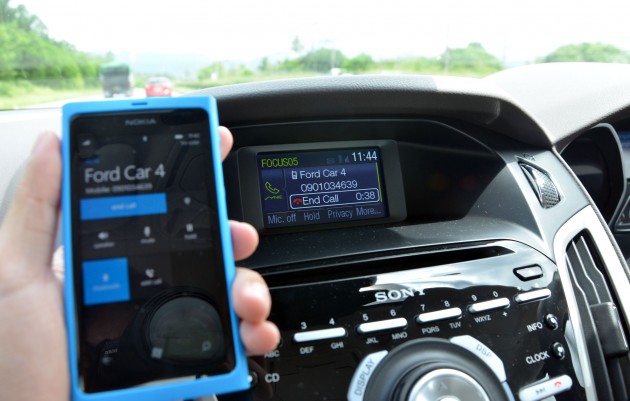
Still on toys, the Focus debuts Ford’s SYNC system in ASEAN. SYNC, powered by Microsoft, links up your smartphone and portable devices to the Focus via Bluetooth.
More than just allowing you to play songs and make phone calls, SYNC lets one use the car’s voice control system to order your phone around, and ask for specific things, like Billie Jean, Rolling In The Deep or a genre like Jazz for instance. A caucasian female voice speaks back, and graphics on the full colour 4.2-inch screen are slick. SYNC is a big upgrade from the system in the Fiesta.
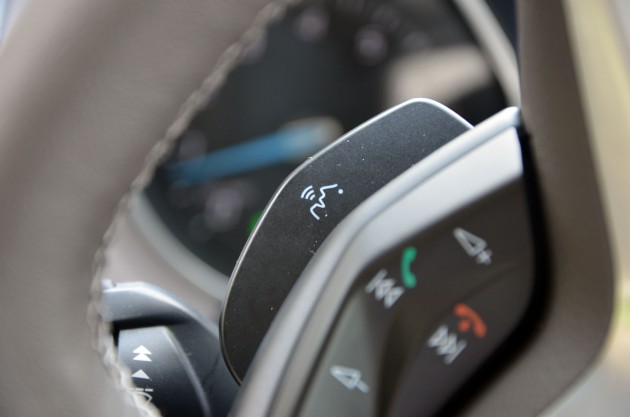
Since everything runs on Bluetooth, all phones with BT are accepted, although our car-to-car calls (loud and clear, even supports multi party) ran on Microsoft powered Nokia phones. Will try it with Android and iOS next time to see if it works just as well. SMS can be viewed on the screen or even read out, with things like “LOL” and “:p” spoken in full. Poking tongue anyone?
The + models take things up a notch by offering toys that some premium cars costing twice as much don’t offer. The range topping Focus side parks itself with Active Park Assist. I’ve only previously tried something like this once, and it was in a Mercedes.
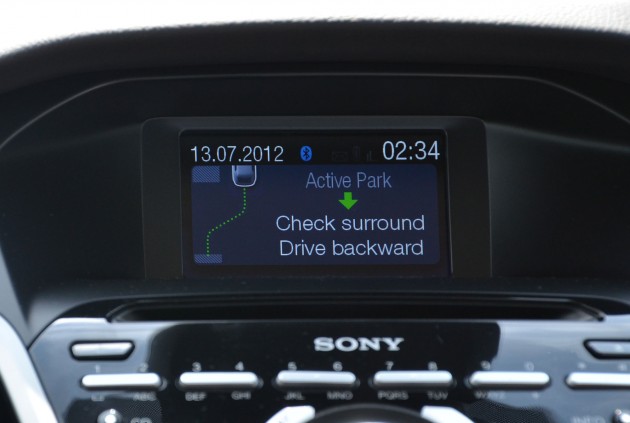
Here’s how it works. If you’re looking for a parallel parking spot, press the APA button and cruise along the line (remember to signal). If there’s a spot, the Focus’ ultrasonic sensors will determine if the gap is big enough for the car (minimum 1.2 times the car’s length) and alerts you if it is. Then, all you need to do is take your hands off the wheel and trust the system, which displays instuctions on the main screen.
As you can see in the video below, the steering will DIY based on the data it has – all the driver has to do is control the brakes and gas pedal, based on the front/rear sensors (with audio and visual display) called ParkPilot. Can be quite unnerving for those new to it, but a few precise attempts is all APA needs to gain one’s trust. When the manoeuvre is done, you will be told so. Useful.
Another high end feature is Active City Stop (ACS), which is rather similar to Volvo’s City Safety. ACS works below 30 km/h and will auto brake the Focus if you’re about to kiss the butt of the car in front unwittingly, minimising damage. Under 15 km/h, ACS will auto brake to a full stop, eliminating fender benders once and for all.
The Titanium +, which is the top end sedan, adds on BLIS blind spot info system. Pioneered by Volvo, BLIS informs the driver of a car in his/her blind spot via a light, but Ford’s light is on the outer edge of the wing mirrors, and not inside the car. Volvo uses a camera on the wing mirror, the Focus’ BLIS uses radar detection.
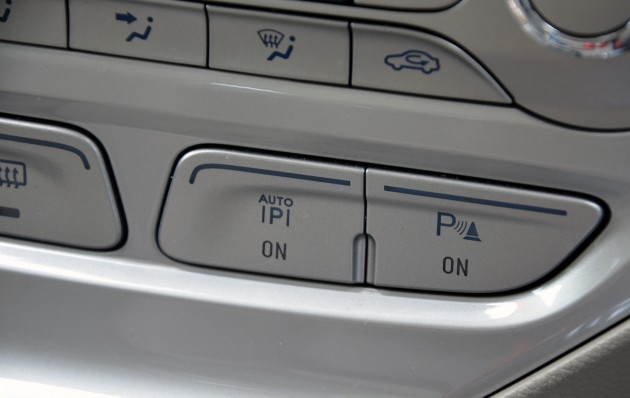
We got to try all three headline features, and I’m very impressed by the Active Park Assist, which beats my parking skills any day. ACS is good to have – you may not need it often, but in the rare occasion when you do, your wallet will be thankful.
In our trial run, we had to consciously drive into a box with reflectors (that’s what the sensors detect, pedestrians not included) which is as unnatural as communicating to a cat by barking. My first run was a failure, as my instinctive right foot sprung into action on approach. ACS took over in the second run, as we dived to a tyre scrubbing halt. Less impressed with the BLIS, which worked, but not 100% of the time for us – another test on local ground is needed. In any case, I prefer Volvo’s big bright orange light over Ford’s rendition.
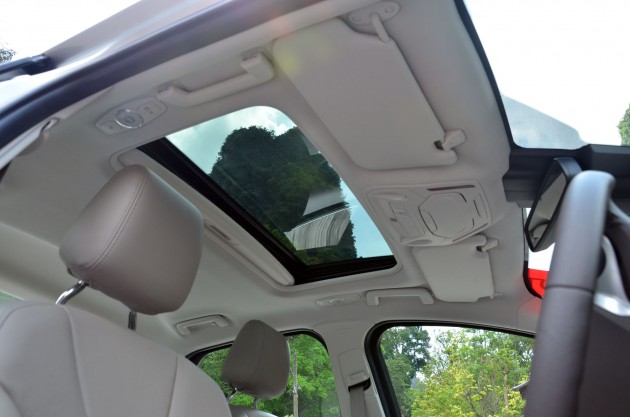
Other features exclusive to the + are bi-xenons with washers, follow me home lighting, power tilt/slide sunroof, auto headlamps/wipers, auto dimming rear view mirror and cruise control. It wasn’t too long ago when Mercedes highlighted Linguatronic and Volvo shouted City Safety and BLIS. Now, a RM130k mass market Ford has all that, and parks itself. It’s the right time to blow the dust off a headline I once used for an Autocar cover story – The Democracy of Technology.
Diving in, there’s a wide range of steering and seat adjustment, so the ideal driving position is easy to find. Once set (manual for hatch, electric for sedan), I found that the seat gripped well and went low enough. The hatch’s black cabin theme and part leather seats are fitting, but I found the sedan’s light hues very refreshing – the full leather seats are very cushy and the breezy feel relaxing.
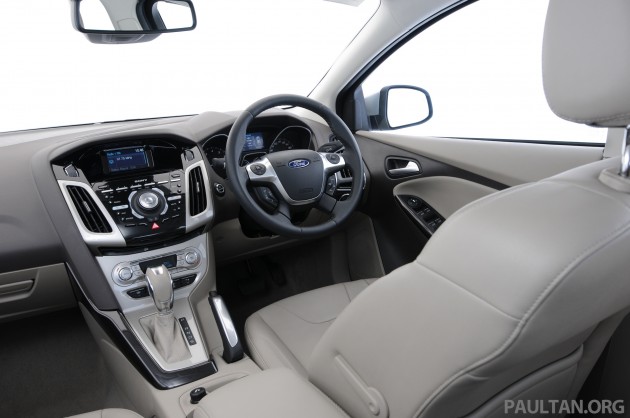
No time to try the rear bench, but I didn’t feel too comfy in the front passenger seat, where the centre console was too intrusive for my right knee. I had to sit in an offset position as a result. It could be the fault of that “boundary” that cordons off the controls to make a “driver focused” cockpit.
Back in the throne, the button-rich steering wheel is to my liking, as it’s not too thick and the leather used is very supple. Clusters of buttons are everywhere, and there are no blank ones, so there’s a nice feeling of being in a full spec car. The layout of the Sony stereo isn’t the most straightforward, but then fancy design and best functionality rarely coexist.
Material quality should please the “knock-knock” Malaysian car buyer – unlike the ASEAN Fiesta, you can sink your nails deep in the soft dash moulding here, and the upper door cap plastics are pilable, too.
So how does it drive? It can’t be bad, it’s a Ford. The engineers at the Blue Oval consistently excel at delivering good ride and handling on mass market offerings, churning out best-to-drive in segment models like the Fiesta, Mondeo and last gen Focus. This new Focus is a big improvement over the old one in many ways, but it doesn’t fully kill our love for the old timer.
Petrol vs petrol, this new GDI engine rights one wrong in the old Focus 2.0 – its lethargic heart. It is not the most charismatic performer and doesn’t have a memorable sound, feel or top end flourish, but at least it has enough grunt to not stand out for the wrong reasons. The power/torque figures may be slightly above par, but the small advantage wasn’t felt on the road. Adequate nonetheless.
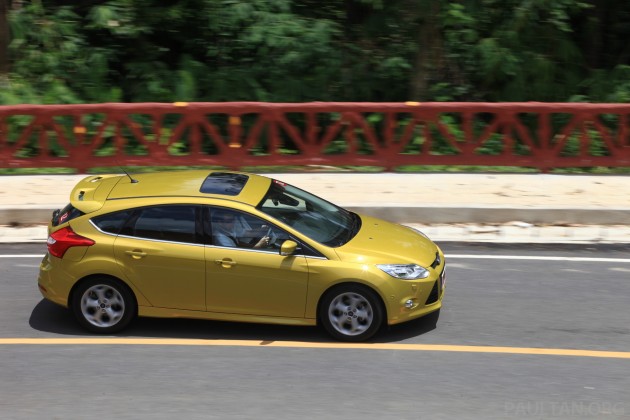
The Powershift six-speed dual-clutch gearbox is good to have at this price point – other than the VW Polo hatch and Ford’s own Fiesta, no other car offers DCT at this money. Compared to the Fiesta, the shifts are smoother and less perceptible in the Focus, which suits the much improved rolling refinement (over both the Fiesta and previous Focus) too.
However, the SelectShift manual override is a major disappointment for me. Ford has elected to incorporate a +/- button on the gear knob itself, instead of the tried and tested seperate slot with up/down movement. Using the button takes too much hand time away from the wheel in fast driving, because you need to hold the lever before pressing the small button – two actions instead of just one. Perhaps the process will get smoother with familiarity, but that still won’t make two steps easier than one. By the way, manual selection can only happen in S mode.
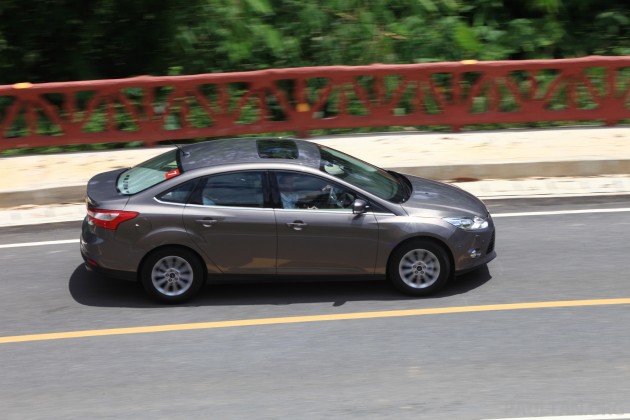
I cannot figure out why Ford chose to reinvent the wheel in this manner – the old way was fine, and if they wanted to provide more convenience, why not just give us steering paddles? Cost doesn’t seem like an issue when the Focus steering wheel has more controls than a luxury car. Mysterious.
The Focus feels really solid and planted, even when exploring the final quarter of the speedometer. We hit a major dip in the road when doing so, and it was us who got unsettled instead of the Focus. Low speed ride comfort is really good as well, with only the biggest of potholes or ridges sending a thud to the cabin. The sedan’s higher profile 205/60 R16 tyres were more cushioning, but the 17-inch wheeled hatch (215/50 rubber) wasn’t too harsh riding.
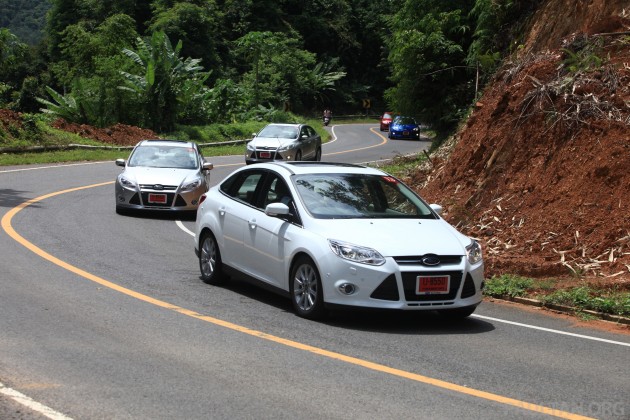
Ford is also keen to highlight Torque Vectoring Control, which uses electronics to replicate the function of a limited slip differential (LSD). The theory is that in a corner, TVC applies minute braking force on the inside front wheel with less traction, channelling drive to the wheel with grip for better cornering performance. Can’t say that I felt it work, but the Focus handles well enough. In a long sequence of bends with plenty of hazards (sand after a blind corner, funny cambers, etc), the agile and composed Focus acquitted itself very well.
The EPAS electric steering is very sharp and quick, but not tiring at a cruise. With zero slack and good weighting, it’s hard to criticise, but the old car’s steering felt more natural; less technically perfect but with plenty of good vibes. That’s a good way to sum up the drive.

The new Focus looks good, has plenty of nice toys, and is still the best driving C-segment car in town, but I feel that it has lost a little bit of that unquantifiable “good vibes” that made the last one so likeable despite its ugly interior. But as an ownership proposition, the new Focus is streets ahead, and the top spec + cars are great value at the estimated prices.
If there’s a scale between the old Focus and the Golf, the new Focus has moved a little more to the VW’s side. No bad thing, of course!
http://paultan.org/2012/07/21/driven-new-ford-focus-hatch-and-sedan-in-krabi/


No comments:
Post a Comment